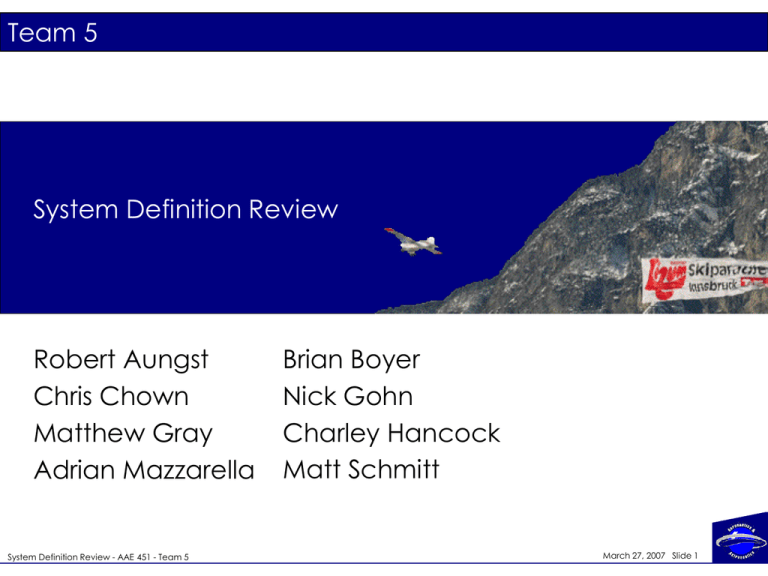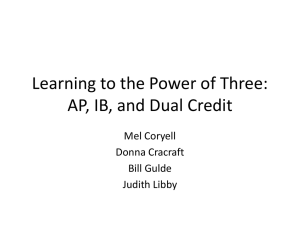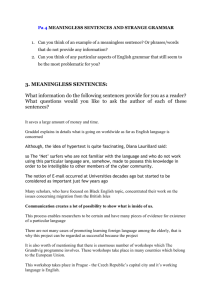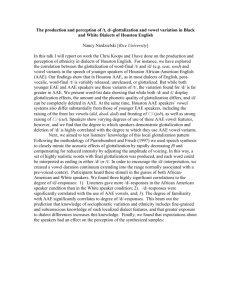Team 5 SDR presentation
advertisement

Team 5 System Definition Review Robert Aungst Chris Chown Matthew Gray Adrian Mazzarella System Definition Review - AAE 451 - Team 5 Brian Boyer Nick Gohn Charley Hancock Matt Schmitt March 27, 2007 Slide 1 Outline of Presentation • Concept of Operations • Design Requirements • Concept Selection • Payload Analysis • Constraint Analysis • Sizing Studies • Final Concept System Definition Review - AAE 451 - Team 5 March 27, 2007 Slide 2 Mission Statement • Our mission is to provide an innovative advertising medium through the use of an Unmanned Aerial System (UAS) System Definition Review - AAE 451 - Team 5 March 27, 2007 Slide 3 Concept of Operations • Continuous area coverage of South Florida metropolitan areas and beaches for advertising purposes • Advertisements change based on location and circumstance – Targeted advertising for specific areas – e.g. advertising Best Buy near Circuit City locations • Large, fuselage mounted LED screens will deliver adverts • Business will be developed around this new technology System Definition Review - AAE 451 - Team 5 March 27, 2007 Slide 4 Concept of Operations • Operations based at Sebring Regional Airport, serving 3 high population areas • Continuous area coverage of city for 18 hrs (6am to 12am) – 3 missions total with 6 hour loiter each • Seven planes needed for 3 city operations with 1 spare • Coverage area map: System Definition Review - AAE 451 - Team 5 March 27, 2007 Slide 5 Concept of Operations • Schedule Generation Application – – – 13 destination choices within 175 nm Sort schedule by Time, Destination, Plane, & Action Allows detailed operations planning System Definition Review - AAE 451 - Team 5 March 27, 2007 Slide 6 Major Design Requirements • Customer Attributes – Advertisement visibility is paramount in order to meet customer’s needs – Must maintain a loiter speed which allows the public to retain the content of advertisements – For a successful venture, these two requirements must be clearly met in order to provide a superior service to the customer • Engineering Requirements – Screen dimensions: 7.42’ x 30’ (each) – Loiter Speed: 60 kts – Loiter Endurance: 6 hrs System Definition Review - AAE 451 - Team 5 March 27, 2007 Slide 7 4 Concepts Must Be Evaluated 2-Screen Machine 2 LED Screens on Fuselage 1-Screen Wonder Wing Screen 2 LED Screens Under Wings Cessna with Banner 1 Banner 1 LED Screen on Fuselage System Definition Review - AAE 451 - Team 5 March 27, 2007 Slide 8 Pugh’s Method – Close Competition Flight Endurance Autonomous Flight Low Fuel Consumption Ground Control Display Dynamacism Stability Visibility of Messages WOW Effect Loiter Time Size of display Cruise Velocity Loiter Velocity Cruise Range Turn Radius Total + Total S Total System Definition Review - AAE 451 - Team 5 2 Screen Machine + + + + S + + + + + S ========== 9 2 3 1 Screen Wonder + + + + + + + + + S ========= 9 1 3 Wing Screen + + + + + + + + S ========= 8 1 5 Banner Tow Cessna DATUM ========== March 27, 2007 Slide 9 Modified Pugh’s Method – Justifying the 2-Screen Concept Flight Endurance Autonomous Flight Low Fuel Consumption Ground Control Display Dynamacism Stability Visibility of Messages WOW Effect Loiter Time Size of display Cruise Velocity Loiter Velocity Cruise Range Turn Radius Importance 8 14 9 5 6 2 12 1 7 11 3 10 4 13 Total Weighted System Definition Review - AAE 451 - Team 5 2 Screen Machine 4 4 2 4 4 3 4 4 4 4 2 2 3 2 ========== 46 344 1 Screen Wonder 4 4 2 4 4 2 3 4 4 4 2 2 3 2 ========= 44 330 Wing Screen 4 4 2 4 4 1 1 3 3 4 2 2 3 2 ========= 39 296 Banner Tow Cessna 1 1 4 1 1 3 2 1 1 3 4 4 2 2 ========== 30 226 March 27, 2007 Slide 10 Payload • Component Selection and Sizing – – – – – Screen Engine Generator Camera Parachute System Definition Review - AAE 451 - Team 5 March 27, 2007 Slide 11 Screen • Two High Intensity LED Screens – 7.42 ft X 30 ft • Viewable up to 1500 ft – 500 lbs installed (each) – $120k cost (each) – Power Consumption • 3.9 kw/5.2 hp, each – Daytime Viewable • Brightness: 6500 cd/m² – Dynamic Display • 60 fps video/text – Weatherproof System Definition Review - AAE 451 - Team 5 March 27, 2007 Slide 12 Engine and Propeller Considerations • Honeywell TPE-331 Turboprop – – – – – Over 14,000 Manufactured 20+ Variants HP ≈ 500-1700 SFC ≈ 0.55 Weight ≈ 350-400 lbs • P&W PT6A Turboprop – – – – – – Over 36,000 Manufactured 50+ Variants HP ≈ 500–1900 SFC ≈ 0.60 Weight ≈ 300-400 lbs Many 4000–8000 lb GTOW Single Engine Applications • Propellers – – – – – – – Hartzell 3,4 Blade McCauley 3,4,5 Blade Diameter ≈ 82-110 in Weight ≈ 50-150 lbs Variable Pitch Aluminum ηp ≈ 0.77 • Cessna Caravan 208 System Definition Review - AAE 451 - Team 5 March 27, 2007 Slide 13 Generator • Used to power screens, avionics, etc • Screen requirements: – 12.89 kW (17.3 hp) AC – 30% efficiency AC-DC-DC conversion. – 12.89 kW/screen X 2 screens X 30% = 7.7 kW DC (10.3 hp) • Options: – Gas-powered APU • + Generates excess power, provides emergency backup power • - Uses considerable fuel, heavy – External propeller-powered APU • + Provides emergency backup power • - Increases drag, adds complexity – Electric generator driven by accessory gearbox • + Simple, supplied and designed by engine manufacturer • - Increases engine cost, no emergency power System Definition Review - AAE 451 - Team 5 March 27, 2007 Slide 14 Camera • Micropilot MP-Dayview – High resolution CCD camera – Designed for UAV applications – Roll and elevation control via joystick – Two-axis gimbal for image stabilization – 25x optical zoom – Weight: 2 lb System Definition Review - AAE 451 - Team 5 March 27, 2007 Slide 15 Parachute Recovery System • Ballistic Recovery Systems – Largest current application: • Cessna 182 (3100 lb GTOW) • Cost: $17,445 • System Weight: 85 lbs – Extrapolated specifications: • Cost: $32,053 • System Weight: 177.5 lbs • Used in the event of catastrophic failure System Definition Review - AAE 451 - Team 5 March 27, 2007 Slide 16 Constraint Analysis • Major performance constraints: – Service Ceiling: • Steady, level flight @ h = 15,000 ft and V = 135 kts – Rate of Climb: • 1,500 ft/min climb rate @ sea level and V = 135 kts – Maximum Acceleration: • Acceleration of 15 ft/s2 in level flight @ h = 10,000 ft and V = 60 kts – Maneuverability: • 1.5g maneuver @ h = 10,000 ft and V = 135 kts – Loiter: • Steady, level flight @ h = 1,000 ft and V = 60 kts – Stall Velocity: • 30% lower than loiter velocity @ sea level – Takeoff Ground Roll: • 2500 ft takeoff ground roll @ sea level – Landing Ground Roll: • 2500 ft landing ground roll @ sea level System Definition Review - AAE 451 - Team 5 March 27, 2007 Slide 17 Constraint Analysis • Equations for Constraint Diagram: – Excess Power: PSL V Wo p q 2 CDo 1 n Wo 1 dh 1 dV W A Re q S V dt g dt o S – Stall Velocity: W 1 Vstall 2CLmax S 2 – Takeoff Ground Roll: 3 Psl 1.32 p Wo 2 Wo g d to CLmax S – Landing Ground Roll: W d landing CLmax g S 1.152 System Definition Review - AAE 451 - Team 5 March 27, 2007 Slide 18 Constraint Analysis • Aircraft Data Assumptions for Constraint Diagram Construction: Standard Atmosphere Fuel Weight Fraction Airspeed Maximum Lift Coefficient (CLmax) Parasite Drag Coefficient (Cd0) 1 135 kts (Cruise) 60 kts (Loiter) 1.2 0.03 Oswald’s Efficiency Factor 0.8 Aspect Ratio 14 Propeller Efficiency .85 / .75 Landing and Takeoff Ground Roll 2,500 ft. Braking Friction Coefficient System Definition Review - AAE 451 - Team 5 30°F 0.3 March 27, 2007 Slide 19 Constraint Diagram Constraint Diagram 0.4 0.35 Service Ceiling: Steady, Level Flight @ h = 15,000 ft. Power-to-Weight (P/W) [hp/lb] 0.3 Rate of Climb: 1,500' per Minute Climb @ Sea Level Maximum Acceleration: Acceleration of 15' per second per second in Level Flight @ h = 10,000 ft. Maneuverability: 1.5g Maneuver @ h = 10,000 ft. 0.25 Design Area: Wing Loading: 8 Power-to-Weight: .18 0.2 Takeoff Ground Roll: 2500 ft. Takeoff Ground Roll @ Sea Level Landing Ground Roll: 2500 ft. Landing Ground Roll @ Sea Level 0.15 Loiter: Steady, Level Flight @ h = 10,000 ft. and V = 60 kts. 0.1 Stall Velocity: 30% lower than Loiter Velocity @ Sea Level 0.05 0 0 10 System Definition Review - AAE 451 - Team 5 20 30 40 Wing Loading (W/S) [lbs/ft^2] 50 60 March 27, 2007 Slide 20 Constraint Diagram - Relevant Region Constraint Diagram 0.3 0.28 Power-to-Weight (P/W) [hp/lb] 0.26 = Service Ceiling: Steady, Level Flight @ h .ft 15,000 0.24 0.22 @ Rate of Climb: 1,500' per Minute Climb Sea Level Design Area: Wing Loading: 8 Power-to-Weight: .18 0.2 'Maximum Acceleration: Acceleration of 15 = per second per second in Level Flight @ h .ft 10,000 = Maneuverability: 1.5g Maneuver @ h .ft 10,000 0.18 Stall Velocity: 30% lower than Loiter Velocity Sea Level @ 0.16 0.14 0.12 0.1 4 5 System Definition Review - AAE 451 - Team 5 6 7 8 Wing Loading (W/S) [lbs/ft^2] 9 10 March 27, 2007 Slide 21 Constraint Diagram • From the Constraint Diagram: – Estimate for ideal starting design for current sizing estimates: • Wing Loading: 8 lbs/ft2 • Power-to-Weight Ratio: .18 hp/lb – Using these values as a starting point, the next step is to create carpet plots System Definition Review - AAE 451 - Team 5 March 27, 2007 Slide 22 Screen Trade Study • Primary Driver: – Can the screen be seen clearly? • • • • Screen size Loiter velocity Loiter altitude Initial Reference: – Billboard advertising - 15 ft X 45 ft – Current LED billboards visible from 2000 ft • Normalized target parameters: – Angular diameter of screen > 0.4° /sec – Angular velocity of aircraft < 1.0°/sec 10 ft 1000 ft System Definition Review - AAE 451 - Team 5 March 27, 2007 Slide 23 Sizing Approach • Design Mission – Sizing done with MATLAB script using empty weight fraction regression from existing UAVs – Future studies to use FLOPS/ACS • Basic assumptions – – – – L/D: 17 AR: 14 Propeller Efficiency: 0.8 Cbhp: 0.55 System Definition Review - AAE 451 - Team 5 March 27, 2007 Slide 24 Aircraft Concept • Isometric Drawing • “Walkaround” Drawing • Internal Layout Drawing • Requirements Compliance System Definition Review - AAE 451 - Team 5 March 27, 2007 Slide 25 Isometric and 3-View Drawing System Definition Review - AAE 451 - Team 5 CONCEPTUAL DRAWING ONLY March 27, 2007 Slide 26 Aircraft Concept – Walk Around Chart High wing configuration Single 550-750 hp piston engine with propeller T-tail empennage configuration High aspect ratio, zero sweep wing System Definition Review - AAE 451 - Team 5 Retractable tricycle landing gear configuration 7.42’ x 30’ advertising screen CONCEPTUAL DRAWING ONLY March 27, 2007 Slide 27 Internal Layout Drawing Tail Camera Screen Avionics Engine Nose Landing gear Fuel Rear Landing gear Fuel Generator Nose Camera Screen Ballistic Recovery System System Definition Review - AAE 451 - Team 5 March 27, 2007 Slide 28 Design Requirements Review • Design requirements review was carried out to verify design requirements. • Further research of requirements led to alteration of design requirements for the mission profile based on the “voice of the customer.” • Design requirements compliance shows the current, target, and initial values. • Initial values changed to target values as a result of the design requirements review. System Definition Review - AAE 451 - Team 5 March 27, 2007 Slide 29 Design Requirements Compliance Requirement Current Target Initial Screen Dimensions (each) 7.42’ x 30’ 7.42’ x 30’ 8’ x 45’ Loiter Velocity 60 kts < 65 kts < 55 kts Loiter Time 6 hrs > 6 hrs > 8 hrs 400 nm > 400 nm > 400 nm 16.6 > 16 > 22 0. 5 lb/BHP/hr 135 kts < 0.5 lb/BHP/hr > 80 kts < 0.5 lb/BHP/hr > 135 kts Cruise Range Loiter L/D (clean) Specific Fuel Consumption Cruise Velocity System Definition Review - AAE 451 - Team 5 March 27, 2007 Slide 30 Next Steps • Detailed design in specific disciplines: • • • • • • • – – – – Aerodynamics Structures Propulsion Flight Mechanics and Performance Detailed aerodynamic sizing. Finalize internal layout and component weights. Select structural materials. Internal structural component design. Landing gear design. Compile necessary carpet plots. Select an engine and finalize propeller dimensions. • Investigate the fuselage color that gives optimized screen visibility. System Definition Review - AAE 451 - Team 5 March 27, 2007 Slide 31 Questions? Thank you for your time! Comments and Questions? System Definition Review - AAE 451 - Team 5 March 27, 2007 Slide 32





